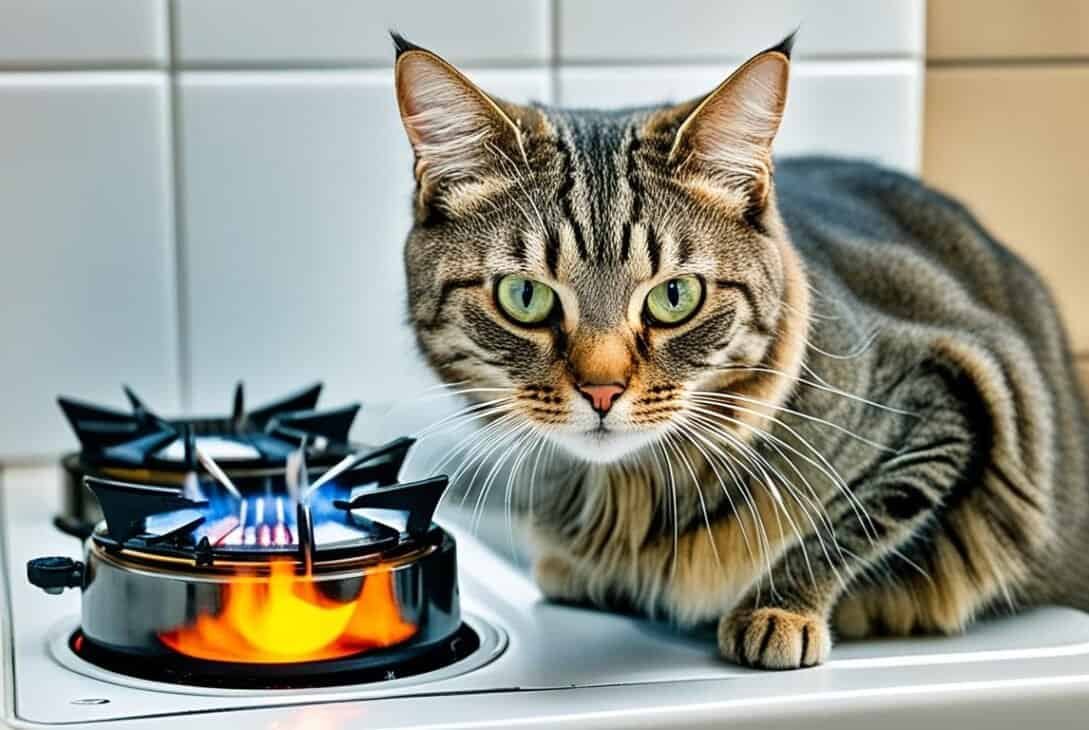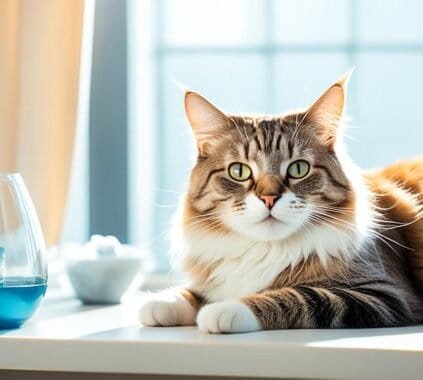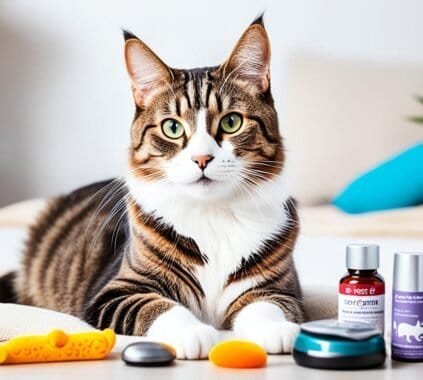Welcome to our guide on cat household hazards, where we will provide you with essential pet safety tips and a cat-friendly home checklist. As cat owners, it’s crucial to ensure the well-being and safety of our feline friends by minimizing potential hazards in our homes. Let’s explore some common household dangers and learn how to create a safe and secure environment for our beloved cats.
Key Takeaways:
- Creating a cat-friendly home involves identifying and eliminating potential hazards.
- Understanding toxic plants for cats is essential for cat-proofing your living space.
- Many everyday household items can be harmful to cats if ingested.
- Preparing for emergencies and knowing how to keep your indoor cat safe is crucial.
- A cat-friendly environment promotes your cat’s well-being, comfort, and safety.
Toxic Plants for Cats
Cats are curious creatures that love to explore their surroundings. Unfortunately, some common household plants can be toxic to felines. It’s crucial for cat owners to be aware of these plants and take steps to keep them out of their homes or inaccessible to their curious pets.
When it comes to plants cat household hazards prevention is key. By cat-proofing your home and creating a safe environment, you can protect your beloved feline friend from potential harm. Let’s take a look at some common plants that are toxic to cats and learn how to ensure your home is safe and free from these dangers.
Plants Toxic to Cats:
- Lilies: Beautiful and fragrant, lilies may seem harmless, but they are highly toxic to cats. Ingesting any part of the plant, including the petals, leaves, pollen, or even the water from the vase, can cause severe kidney damage.
- Aloe Vera: While aloe vera is well-known for its medicinal properties, it can be toxic to cats when ingested in large quantities. Keep this plant out of your cat’s reach to prevent digestive issues and potential poisoning.
- Dieffenbachia: Also known as dumb cane, dieffenbachia contains calcium oxalate crystals that can cause intense burning and irritation in a cat’s mouth and throat if chewed or ingested.
- Pothos: The pothos plant, with its heart-shaped leaves, is a popular choice for indoor gardens. However, it is toxic to cats and can cause gastrointestinal upset, vomiting, and difficulty breathing.
To create a cat-proof home, it’s essential to identify and remove any toxic plants that you may already have. Additionally, consider replacing them with pet-safe alternatives to ensure your cat’s well-being.
Remember, even non-toxic plants can be harmful if your cat ingests large amounts. It’s always best to supervise your cat’s interactions with indoor plants and limit access to any greenery. This will significantly reduce the risk of plant-related emergencies.
By staying informed about toxic plants for cats and taking proactive measures to cat-proof your home, you can provide a safe and healthy environment for your feline companion.
Common Dangers for Cats
When it comes to ensuring the health and safety of your beloved feline friend, it’s crucial to be aware of the common dangers that can lurk within your home. Everyday household items that may seem harmless to us can actually pose a significant risk to our cats. By familiarizing yourself with these potential dangers and taking precautions, you can help mitigate the risks and create a safer environment for your furry companion.
Household Items Toxic to Cats
- Cleaning products: Many household cleaning products contain chemicals that can be toxic to cats if ingested or inhaled. Keep these products securely stored in cabinets or high shelves that are out of your cat’s reach. Alternatively, consider using pet-friendly cleaning alternatives.
- Medications: Human medications, both prescription and over-the-counter, can be extremely harmful to cats. Ensure all medications are stored in a secure location and never leave pill bottles or medications within your cat’s reach.
- Plastic bags and wrappers: Cats are naturally curious and may play with or chew on plastic bags and wrappers. This can lead to choking hazards or intestinal blockages. Be sure to properly dispose of these items and avoid leaving them lying around.
- Household plants: Certain plants can be toxic to cats if ingested. Some common examples include lilies, azaleas, and philodendrons. Check the ASPCA’s list of toxic plants to ensure you don’t have any harmful foliage in your home.
- Electrical cords: Cats are attracted to electrical cords and may chew on them, leading to electric shocks or injuries. Keep cords secured and out of your cat’s reach or use cord concealers to prevent access.
Non-Toxic Alternatives
Fortunately, there are safer alternatives to many household items that can pose a danger to cats. Consider opting for pet-friendly cleaning products or natural remedies, such as vinegar and baking soda, to clean your home. Additionally, you can decorate your living space with cat-friendly plants that are non-toxic, such as spider plants or Boston ferns.
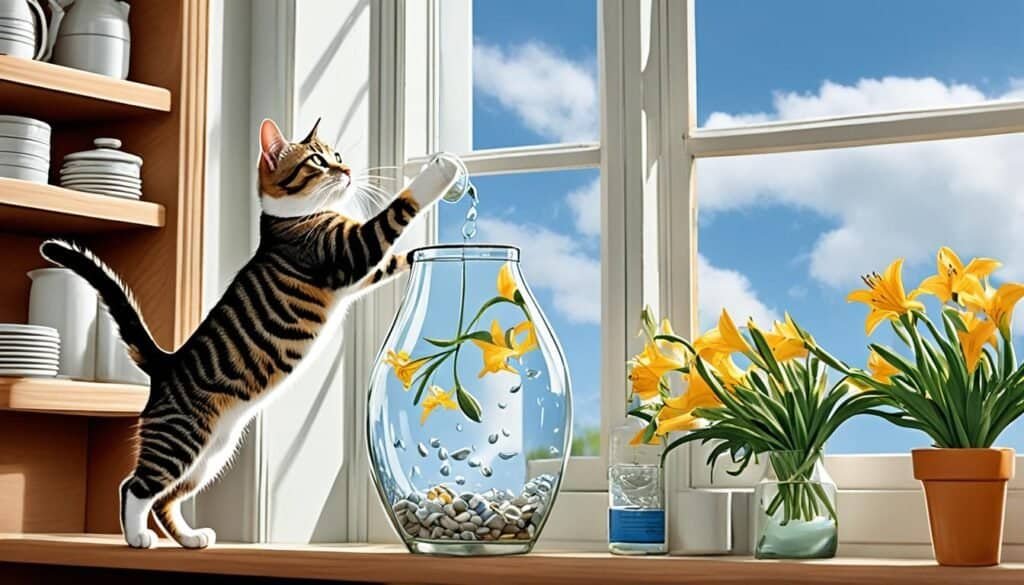
By being proactive and taking measures to eliminate or minimize these common dangers, you can ensure a safer and healthier environment for your feline companion.
Pet Emergency Preparedness
When it comes to the safety and well-being of your indoor cat, it’s important to be prepared for emergencies. Having a plan in place and knowing how to keep your furry friend safe and secure in various situations can make all the difference. Here are some essential pet emergency preparedness tips to ensure the safety of your indoor cat:
- Create an emergency kit: Assemble a kit with essential items for your cat, including food, water, medications, and familiar comfort items like blankets or toys. Store the kit in an easily accessible location.
- Keep important documents handy: Gather your cat’s medical records, identification, and vaccination records, and store them in a waterproof container. In case of an emergency, you’ll have everything you need to provide necessary information.
- Identify safe hiding spots: Cats may seek shelter during emergencies or times of stress. Ensure that your indoor cat has access to safe hiding spots, such as cardboard boxes or a designated room with no hazards.
- Prepare an evacuation plan: Create an evacuation plan specific to your home and identify escape routes. Practice the plan with your cat, so they become familiar with the process.
- Use a secure carrier: Have a sturdy carrier readily available to transport your cat safely in case of a sudden evacuation or emergency.
- Keep contact information updated: Make sure your cat’s identification tags and microchip information are up to date, including your current address and phone number. This ensures they can be easily reunited with you if they get lost during an emergency.
- Prepare for power outages: Keep battery-powered flashlights, extra batteries, and a portable charger for your phone in your emergency kit. This will help you navigate in the dark and stay connected during power outages.
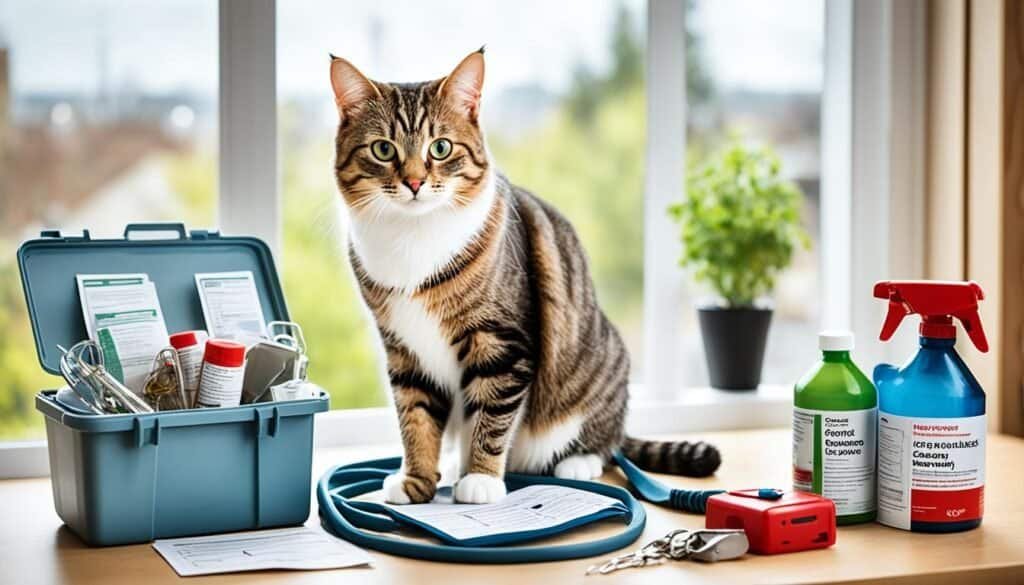
By following these pet emergency preparedness tips, you can ensure the safety and well-being of your indoor cat during unexpected situations and cat household hazards. Being proactive and prepared will give you peace of mind and allow you to focus on keeping your beloved furry companion safe.
Creating a Cat-Friendly Environment
Ensuring that your home is a safe and welcoming space for your feline companion is essential for their well-being and happiness. By following a cat-friendly home checklist and cat-proofing your living space, you can provide an environment that promotes your cat’s comfort and safety and avoid cat household hazards.
To begin, evaluate your home for potential hazards. Keep in mind that cats are curious creatures and can easily get themselves into trouble. Remove any toxic plants from your home and replace them with cat-friendly alternatives. It’s also important to secure loose wires, cover electrical outlets, and keep harmful chemicals out of your cat’s reach and prevent cat household hazards.
Another consideration is providing vertical spaces for your cat to explore and perch. Install cat trees or shelving units that allow them to climb and observe their surroundings from a higher vantage point. Cats also enjoy having cozy hiding spots, so consider providing them with covered beds or enclosed cat condos.
Make sure your cat has access to fresh water and clean litter boxes. Place multiple litter boxes throughout your home, especially if you have a multi-level dwelling, to ensure that your cat can easily find and use them. Additionally, provide scratching posts and toys to keep your cat mentally stimulated and physically active.
Lastly, create designated areas for your cat’s food, water, and resting spots. Cats appreciate having their own space, so setting up a feeding station and a comfortable bed in a quiet corner of your home can make a big difference in their overall happiness. Remember to provide them with plenty of love, attention, and interactive playtime to keep their spirits high.
By following these cat-friendly home checklist guidelines and cat-proofing your living space, you can create a harmonious environment that promotes your cat’s well-being and ensures their safety. Your furry friend will thank you with purrs and cuddles!
Ensuring a Hazard-Free Home
While implementing basic pet safety tips and being aware of common dangers for cats is essential, there are additional safety measures you can take to ensure a hazard-free home for your feline companion.
One of the first steps is to identify and remove household items that are toxic to cats. Certain plants, cleaning products, pesticides, and medications can be extremely dangerous if ingested. Create a cat-friendly environment by replacing toxic plants with pet-safe alternatives and storing hazardous substances securely out of your cat’s reach.
Furthermore, carefully inspect your home for potential dangers. Secure loose cables and cords, as they can pose a strangulation risk. Install window screens to prevent falls or escapes, especially if you live in a high-rise building. Keep small objects, such as jewelry and sewing materials, safely stored away to prevent choking and other cat household hazards.
When it comes to electrical appliances, ensure they are turned off and unplugged when not in use. Cats may be curious and chew on cords, risking electric shock or even house fires. Utilize cord protectors or deterrent sprays to discourage your cat from nibbling on cables.
Additional pet safety tips:
- Securely anchor heavy furniture and appliances to prevent them from toppling over.
- Keep doors, windows, and screens in good repair to prevent your cat from escaping or getting trapped.
- Store toxic substances, such as antifreeze and household chemicals, in securely sealed containers and locked cabinets.
- Avoid using cleaning products that contain chemicals harmful to cats. Opt for natural, pet-safe alternatives.
Paying attention to these potential hazards and taking proactive steps to safeguard your home can significantly reduce the risk of accidents and ensure a safe environment for your beloved feline companion.
Conclusion
Creating a cat-friendly home and being aware of potential cat household hazards is crucial for the safety and well-being of your feline companion. By implementing safety measures and following pet safety tips, you can create a secure and happy environment for your cat.
From toxic plants to common household items that can pose a danger to cats, it is important to be informed and proactive in cat-proofing your living space. Regularly inspect your home, remove any toxic plants, and secure dangerous items out of your cat’s reach.
In addition, preparing for emergencies and having an indoor cat safety plan ensures that your furry friend remains safe even in unexpected situations to avoid cat household hazards. Create a pet emergency kit, including essential supplies and important documents, and designate a safe area within your home for your cat during emergencies.
By taking these steps and addressing potential hazards, you can provide a cat-friendly environment that promotes your cat’s health and happiness. Remember, a safe home is a happy home for your feline companion.
FAQ
What are some common cat household hazards?
What are some toxic plants for cats to avoid?
How can I cat-proof my home?
What are some common dangers for cats in the household?
How can I prepare for pet emergencies?
What can I do to create a cat-friendly environment?
How can I ensure a hazard-free home for my cat?
Last modified: March 13, 2024

